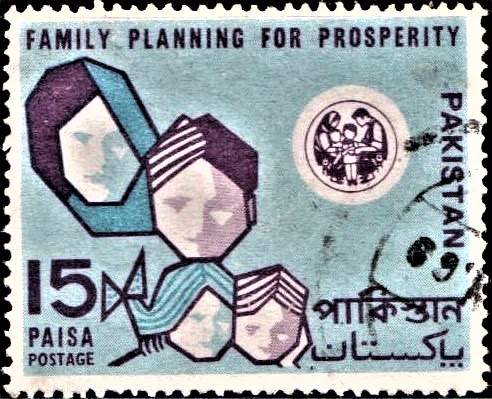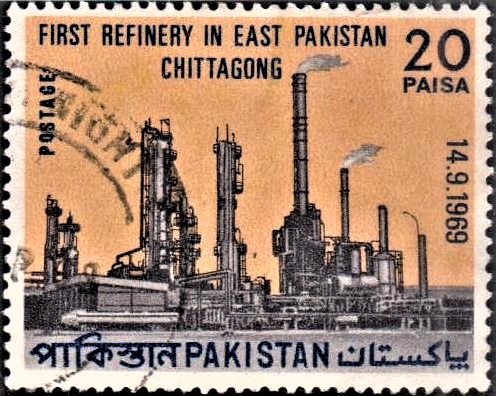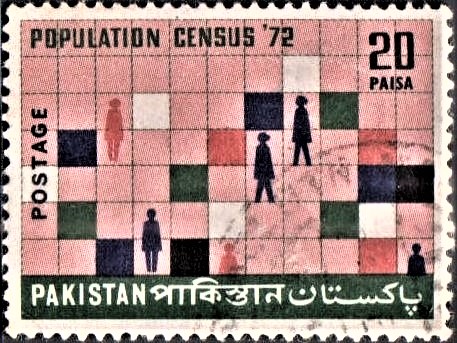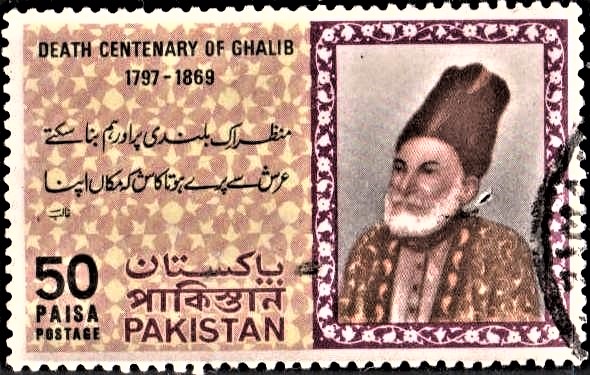
Pakistan on Family Planning 1969
A commemorative postage stamp to publicize Family Planning for Prosperity :
 Issued by Pakistan
Issued by Pakistan
Issued on Jan 14, 1969
Issued for : The Pakistan post Office is issuing a stamp of 15 Paisa denomination to focus public attention to the concept of Family Planning. The Commemorative Postage Stamp will be available for sale on and from 14th January, 1969 for a period of three months at all important Post Offices, Philatelic Bureaux and Philatelic Counters and also at some of the Pakistan Diplomatic Missions abroad. Thereafter, if the supplies are still available, they will be sold only at the Philatelic Bureaux and Philatelic Counters.
Design : The stamps is horizontal in format. Four figures in abstract representing happy family comprising of parents and two children appear at the left hand side of the stamp in bold outline of Mauve Colour against a blue background. The insignia of ‘Family Planning Division’ appears in mauve colour in a white circle at the top right corner. The entire lettering is in Mauve colour on a blue background. The caption “Family Planning for Prosperity” appears at the top, the word ‘Pakistan’ in English at the right side vertically. ‘Pakistan’ in Bengali and Urdu appears together in the bottom right corner horizontally. The denomination figure ‘15’ appears in the bottom left corner with ‘Paisa’ and ‘Postage’ underneath.
Type : Stamp, Postal Used
Denomination : 15 Paisa
Colour : Blue and Mauve
Size of Stamp : 33 x 41 mm.
Size of Print : 30 x 38 mm.
Perforation Gauge : 13 x 13½ (c)
Quantity Printed : 15,00,000
Number of Stamps in each sheet : 50
Process of Printing : Litho Offset
Printers : The Pakistan Security Printing Corporation Ltd., Karachi
About :
- Since the turn of the present century, the areas constituting Pakistan have been experiencing an increasing rate of population growth. The population enumerated in the area was 45.5 million in 1901, 75.8 million in 1951 and 93.8 million in 1961. Thus, during the first half of the century (1901-51), the population increased by 30 million or 6 million per decade, for an annual rate rising to just over 1% per annum. During the last Decade (1951-61), the increase in number was three times as large as the average per decade for the previous 5 periods. Pakistan’s Planning Commission, however, observed that the 1961 census was subject to a considerable under-enumeration, particularly in the age group of 0-3 and in the case of females. When corrections were made for this under-count the population of the country in 1961 was estimated to be about 101.5 million. As such on this estimation, the total population of the country at the beginning of the current Five-Year Plan in July 1965 was 115.6 million, with an estimated birth rate of 50 per thousand and a death rate of 20 per thousand, yielding a natural increase of 30 per thousand and a growth rate approaching 3% per year which is among the highest in the world. This first multiplication of our numbers is largely responsible for keeping the per capita daily income at a low level inspite of the fact that the pace of economic development in Pakistan is one of the highest among the developing countries.
- The current rapid rate of population growth coupled with a high dependency load, the proportion of children under 15 being 44.5% of the population as against 25 in western countries, further aggravates the problem on the economic front. Such a high dependency load adversely effects capital formation as a greater portion of economic gain is absorbed in meeting current consumption needs and the cost of augmenting the health, education and other welfare services, thereby reducing savings available or the investment so essential for future development.
- During the 2nd Five-Year Plan (1960-65) about 40% of the economic growth was absorbed by population increase thus detracting from a significant impact on the per capita income. Economic growth during the current Plan period (1965-70) is estimated to be 7 or 8 per cent, but the increase in per capita income will not be so meaningful unless substantial reduction in the birth rate is achieved.
- It is against this background that Pakistan has embarked upon a national movement of Family Planning during Third Five-Year Plan (1965-70). It is a part of the long term 20 years perspective plan (1965-85) which is a blue print for achieving economic self-sufficiency for the country and amelioration of the conditions of the people by curtailment of the exceedingly high rate of population growth. Accordingly, on the basis of the experience gained during the Second Plan, a revised and more comprehensive Family Planning Scheme costing Rs. 284 million has been incorporated in the Third Plan. The current Scheme in Pakistan is postulated on six basic assumptions : (i) Family Planning efforts need to be public relations oriented and not merely clinical; (ii) Operations should be conducted through autonomous bodies with decentralised authority at all tiers right down to the grass root level, for expeditious decision making; (iii) Monetary incentives play an important role; (iv) Inter-personal motivation in terms of life experience of the clientele through familiar contact coupled with mass media of publicity should be used; (v) Supplies and services in all related disciplines should be available at the door steps of the people; and (vi) Training, evaluation and research should be multi-dimensional and continual as an integral part of the Programme.
- The minimum goal set for the Programme is to reduce birth rate from an estimated 50 to 40 per thousand by reaching all the estimated 20 million fertile couples by 1970. Assuming further moderate decline in the death rate from 20 to 15 per thousand, this would yield a net decline in the growth rate from 3% to 2.5%. This goal is to be achieved by making family planning services and knowledge available to the entire population by 1970. The ultimate goal of the programme is to bring the population growth rate down to 1.5% by 1985.
- After three years of operations, the number of persons working for the Family Planning Programme today exceeds 100,000 (including 50,000 agents registered for distribution of conventional contraceptives at the rate of one agent per 1000 population). This provides the basic infrastructure for effective implementation of the Programme. The Family Planning movement is gathering new strides and fresh momentum every day. The number of coil cases done during the last three years is 2 million and that of sterilizations more than half a million. The sales of conventional contraceptive are in the region of 15 million a month and aggregate to over 450 million units. But for an effective and dynamic Family Planning Programme in the country, it would not be possible to achieve the targets of socio-economic development and national prosperity. Current Family Planning movement has arrested the growing birth rate, and reduce the annual rate of population growth from 3 to 2.5%. Thus, during the current Plan period, at least 70% of the economic growth will be available to augment the per capita income of each citizen of this country. If Government had not launched the Family Planning movement, 40% of the increase in the Gross National Produce would have been absorbed by population increase and only 60% of it would have gone towards augmentation of per capita income. This difference of 10% in the available surplus for distribution among the people of Pakistan represents over Rs. 500 crore and has been obtained by an investment of only Rs. 30 crore on the Family Planning Scheme. In economic terms, investment on Family Planning has a higher capital output ratio than that in any other Sector in national development.
- Issued by The Director-General, Pakistan Post Office, Karachi.








[…] Family planning is one the cheapest developing means available, and also safer to use. The family health benefits and freedom of choice it brings to women, have contributed to the rising voluntary adoption rate from 10% of couples in 1960 to 51% today. […]